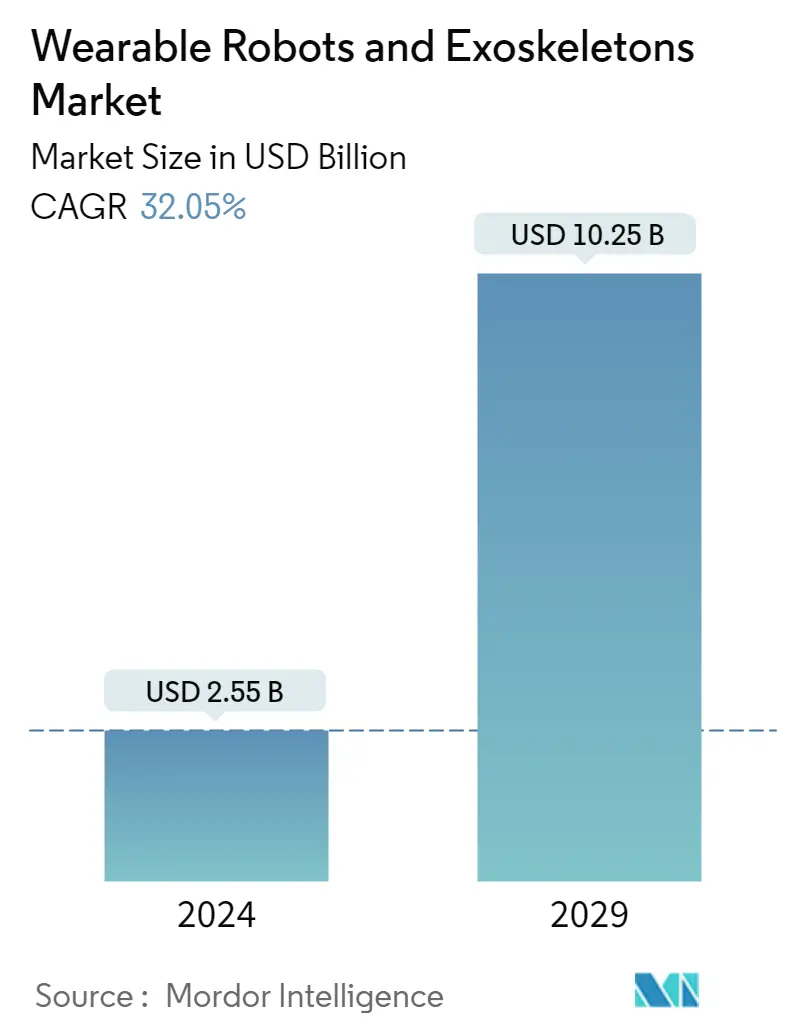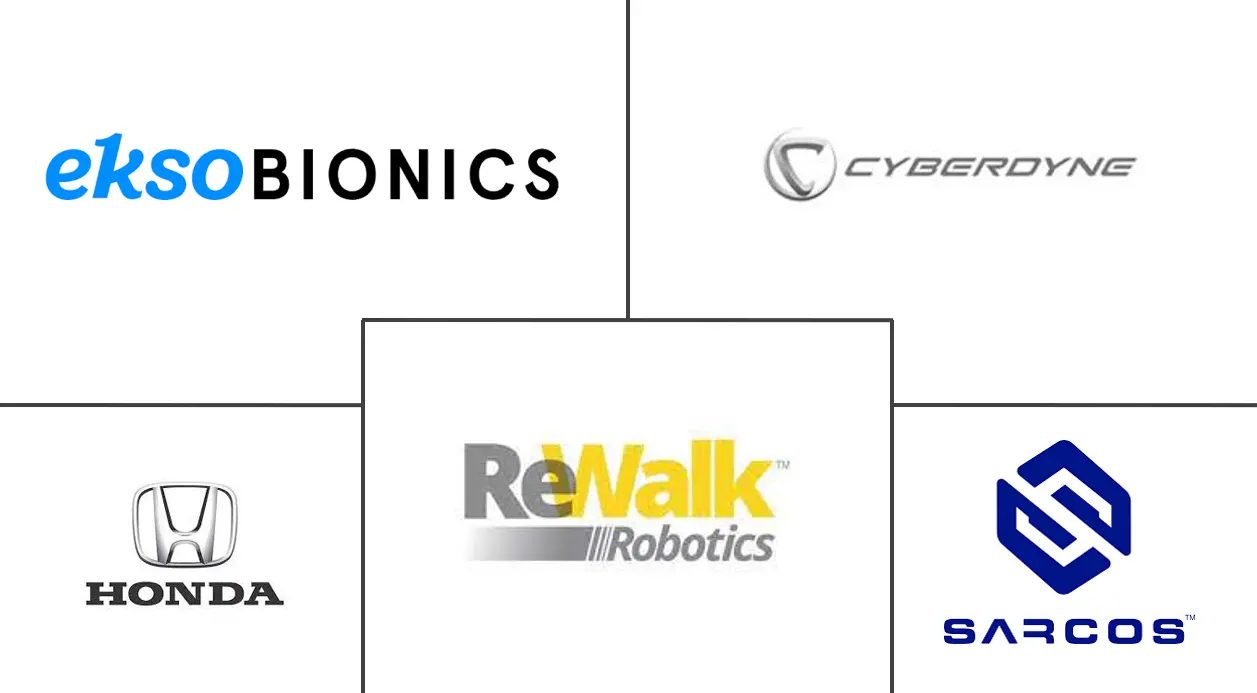Market Size of Wearable Robots and Exoskeletons Industry

| Study Period | 2019 - 2029 |
| Market Size (2024) | USD 2.55 Billion |
| Market Size (2029) | USD 10.25 Billion |
| CAGR (2024 - 2029) | 32.05 % |
| Fastest Growing Market | Asia Pacific |
| Largest Market | North America |
| Market Concentration | Low |
Major Players
*Disclaimer: Major Players sorted in no particular order |
Wearable Robots & Exoskeletons Market Analysis
The Wearable Robots and Exoskeletons Market size is estimated at USD 2.55 billion in 2024, and is expected to reach USD 10.25 billion by 2029, growing at a CAGR of 32.05% during the forecast period (2024-2029).
Due to the emergence of the COVID-19 pandemic, the previously put lockdown measures across various regions significantly brought the robotic suppliers to a complete standstill for a short period. However, on the other hand, the pandemic has also created productive industry opportunities for the products and service providers to increase their presence in the market by primarily focusing on and addressing real clinical challenges in collaboration with clinicians and industry partners and in response to the evolving patients' needs.
- The wearable robots or exoskeletons are in their nascent stage of development and continuously evolving to exhibit maximum adoption in various industries, like healthcare, industrial, military, and defense, as these wearable exoskeletons assist personal mobility and can be worn on the human body and control and assists the movements of the person.
- In the healthcare sector, exoskeletons are helping patients' recovery by assisting and encouraging upright walking and relearning lost functions for stroke patients and people who are paralyzed. According to a study by Maxon Motor AG, the company estimated that approximately 185 million people use a wheelchair daily worldwide.
- For instance, Ekso GT is an exoskeleton by Esko Bionics, which is a wearable exoskeleton engineered as a comprehensive gait therapy tool and provides an unparalleled rehabilitation experience for patients and therapists. Additionally, due to technological developments in technology, a paralyzed man started walking using a mind-controlled exoskeleton in France.
- Various companies in the industry have already tested exoskeletons for their manufacturing capabilities and are ready to deploy them, which is likely to augment the market in the future further. For instance, automobile manufacturer, Ford, planned to deploy exoskeletons in fifteen assembly plants worldwide and adopted the EksoVest. This exoskeleton elevates and supports the arms of workers performing repeated overhead tasks. The adoption of EksoVests reduced workplace injuries by 83% during the trial period.
- There is also an increasing demand for exoskeletons to assist in personal mobility. An increasing number of patients with body movement disorders, such as Parkinson's disease, strokes, etc., are the prime factors accelerating the exoskeleton demand, as these diseases limit voluntary body movements and create problems in daily routine activities. For instance, according to the Parkinson's Foundation estimates, the number of people in the United States with Parkinson's disease may be around 930,000 in 2020, and it is expected to reach 1,200,000 by 2030.
Wearable Robots & Exoskeletons Industry Segmentation
The study categorizes the type of exoskeletons as powered exoskeletons and passive exoskeletons. The study also categorizes the use of wearable exoskeletons in various end-user segments, such as healthcare, military and defense, and industrial, among others. The market studied is tracked based on the revenue accrued by vendors operating in the market, received from the sales/rental of the exoskeleton and wearable robots used to enhance the performance of users. Prosthetics are not considered under the scope of the study. Further, the report also covers the analysis of the COVID-19 impact on the market and stakeholders, and the same has been considered for the current market estimation and future projections.
| By Type | |
| Powered Exoskeletons | |
| Passive Exoskeletons |
| By End-user Industry | |
| Healthcare | |
| Military and Defense | |
| Industrial | |
| Other End-user Industries |
| By Geography | |
| North America | |
| Europe | |
| Asia Pacific | |
| Rest of the World |
Wearable Robots and Exoskeletons Market Size Summary
The wearable robots and exoskeletons market is poised for significant growth, driven by advancements in technology and increasing applications across various sectors such as healthcare, industrial, military, and defense. These devices, still in their early stages of development, are designed to assist personal mobility by being worn on the human body, aiding in movement control and support. In healthcare, for instance, exoskeletons are proving beneficial in rehabilitation, helping patients recover and regain lost functions. The demand for these technologies is further fueled by the rising number of individuals with movement disorders, such as those affected by Parkinson's disease or strokes, creating a substantial market opportunity for companies offering innovative solutions.
The Asia-Pacific region, particularly South Korea and Japan, is at the forefront of research and development in wearable robot technology, with significant investments from both government and private sectors. Companies like Samsung and Ekso Bionics are actively expanding their presence in this region, leveraging the growing interest and demand for wearable robots. The market is highly competitive, with major players like Cyberdyne Inc., ReWalk Robotics Inc., and Ekso Bionics Holdings Inc. leading the charge, while also attracting numerous startups. This competitive landscape is further intensified by strategic partnerships and product innovations aimed at enhancing market share and addressing the evolving needs of various industries.
Wearable Robots and Exoskeletons Market Size - Table of Contents
-
1. MARKET INSIGHTS
-
1.1 Market Overview
-
1.2 Industry Attractiveness - Porter's Five Forces Analysis
-
1.2.1 Threat of New Entrants
-
1.2.2 Bargaining Power of Buyers
-
1.2.3 Bargaining Power of Suppliers
-
1.2.4 Threat of Substitute
-
1.2.5 Intensity of Competitive Rivalry
-
-
1.3 Assessment of the COVID-19 Impact on the Industry
-
-
2. MARKET SEGMENTATION
-
2.1 By Type
-
2.1.1 Powered Exoskeletons
-
2.1.2 Passive Exoskeletons
-
-
2.2 By End-user Industry
-
2.2.1 Healthcare
-
2.2.2 Military and Defense
-
2.2.3 Industrial
-
2.2.4 Other End-user Industries
-
-
2.3 By Geography
-
2.3.1 North America
-
2.3.2 Europe
-
2.3.3 Asia Pacific
-
2.3.4 Rest of the World
-
-
Wearable Robots and Exoskeletons Market Size FAQs
How big is the Wearable Robots and Exoskeletons Market?
The Wearable Robots and Exoskeletons Market size is expected to reach USD 2.55 billion in 2024 and grow at a CAGR of 32.05% to reach USD 10.25 billion by 2029.
What is the current Wearable Robots and Exoskeletons Market size?
In 2024, the Wearable Robots and Exoskeletons Market size is expected to reach USD 2.55 billion.

